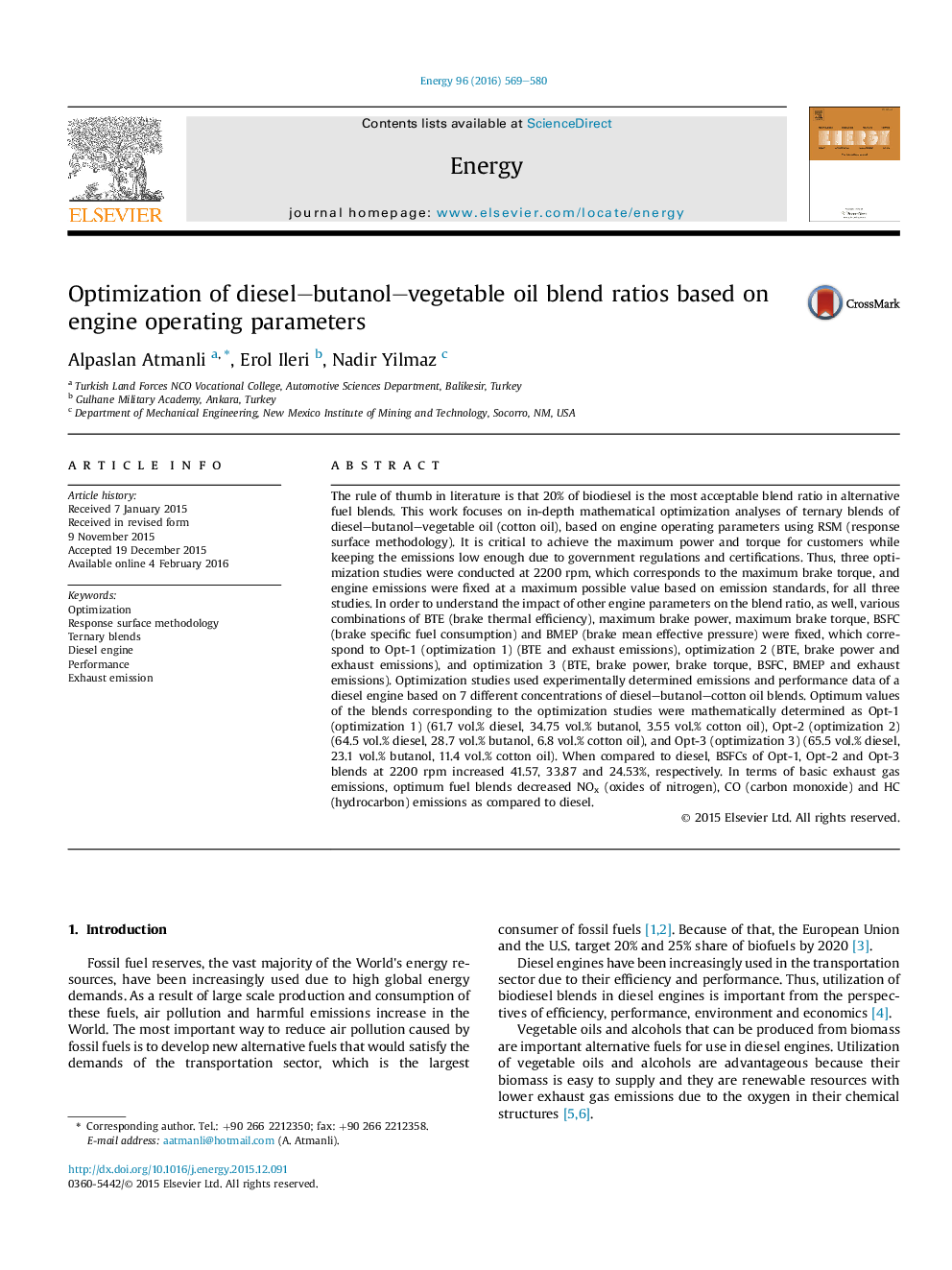| کد مقاله | کد نشریه | سال انتشار | مقاله انگلیسی | نسخه تمام متن |
|---|---|---|---|---|
| 1731294 | 1521452 | 2016 | 12 صفحه PDF | دانلود رایگان |
عنوان انگلیسی مقاله ISI
Optimization of diesel-butanol-vegetable oil blend ratios based on engine operating parameters
ترجمه فارسی عنوان
بهینه سازی نسبت مخلوط نفت روغن دیزل-بوتانول بر اساس پارامترهای عملکرد موتور
دانلود مقاله + سفارش ترجمه
دانلود مقاله ISI انگلیسی
رایگان برای ایرانیان
کلمات کلیدی
بهینه سازی، روش سطح پاسخ، مخلوط ترناری، موتور دیزل، کارایی، انتشار اگزوز،
موضوعات مرتبط
مهندسی و علوم پایه
مهندسی انرژی
انرژی (عمومی)
چکیده انگلیسی
The rule of thumb in literature is that 20% of biodiesel is the most acceptable blend ratio in alternative fuel blends. This work focuses on in-depth mathematical optimization analyses of ternary blends of diesel-butanol-vegetable oil (cotton oil), based on engine operating parameters using RSM (response surface methodology). It is critical to achieve the maximum power and torque for customers while keeping the emissions low enough due to government regulations and certifications. Thus, three optimization studies were conducted at 2200Â rpm, which corresponds to the maximum brake torque, and engine emissions were fixed at a maximum possible value based on emission standards, for all three studies. In order to understand the impact of other engine parameters on the blend ratio, as well, various combinations of BTE (brake thermal efficiency), maximum brake power, maximum brake torque, BSFC (brake specific fuel consumption) and BMEP (brake mean effective pressure) were fixed, which correspond to Opt-1 (optimization 1) (BTE and exhaust emissions), optimization 2 (BTE, brake power and exhaust emissions), and optimization 3 (BTE, brake power, brake torque, BSFC, BMEP and exhaust emissions). Optimization studies used experimentally determined emissions and performance data of a diesel engine based on 7 different concentrations of diesel-butanol-cotton oil blends. Optimum values of the blends corresponding to the optimization studies were mathematically determined as Opt-1 (optimization 1) (61.7Â vol.% diesel, 34.75Â vol.% butanol, 3.55Â vol.% cotton oil), Opt-2 (optimization 2) (64.5Â vol.% diesel, 28.7Â vol.% butanol, 6.8Â vol.% cotton oil), and Opt-3 (optimization 3) (65.5Â vol.% diesel, 23.1Â vol.% butanol, 11.4Â vol.% cotton oil). When compared to diesel, BSFCs of Opt-1, Opt-2 and Opt-3 blends at 2200Â rpm increased 41.57, 33.87 and 24.53%, respectively. In terms of basic exhaust gas emissions, optimum fuel blends decreased NOx (oxides of nitrogen), CO (carbon monoxide) and HC (hydrocarbon) emissions as compared to diesel.
ناشر
Database: Elsevier - ScienceDirect (ساینس دایرکت)
Journal: Energy - Volume 96, 1 February 2016, Pages 569-580
Journal: Energy - Volume 96, 1 February 2016, Pages 569-580
نویسندگان
Alpaslan Atmanli, Erol Ileri, Nadir Yilmaz,
